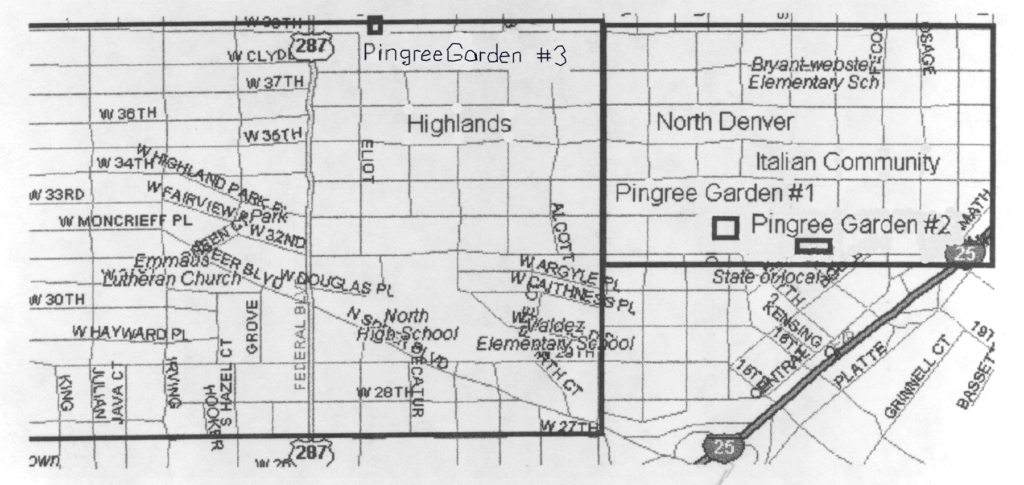By Rebecca A. Hunt
One of the best things about our North Side neighborhoods is the number of residents who contribute to our sustainability ethos, which includes urban gardening. Many individuals have turned part of their lots into food-producing gardens that nourish their families and often yield enough to donate or sell.
Gardens are not a new phenomenon. In the late 1800s, the North Side Women’s Club (NSWC) and Women’s Club of Denver (WCD) set up community and school gardens in the North Side. The clubs acquired the plots partly because they were adjacent to the streetcar lines, which allowed access for people from other parts of the city.
Members of both clubs followed the ideals of the Social Gospel movement. Influenced by Hazen Pingree, the socialist-reform mayor of Detroit, and local reformers like Denver’s Rev. Myron Reed, they practiced a more cooperative form of aid than some of their more mainstream sisters. This allowed immigrants to make use of resources on their own terms.
In 1894, the WCD began a project called Pingree Gardens, named after Mayor Pingree. The gardens were originally located in central Denver, then the women acquired four plots totaling about 10 acres in North Denver. Two were on land donated by Andrew Wilson, the first on Goss (Tejon) Street between West 32nd and West 33rd, and the second on West 32nd between Arlington (Shoshone) and Witter (Quivas) streets. The third was located near West 38th and Eliot streets, and the fourth was at the site of the Acacia Cemetery, a Masonic and Odd Fellows graveyard at the site of the 1890s-built Asbury Methodist Church (3011 Vallejo St.) that now serves as The Kirk of Highland event venue. Gardens one and two were in the Italian section of North Denver.

The group’s published intent was “to keep aimless persons continuously working and learning the value of self-support.” Their words sound like a cold ideology of superiority, but the women’s clubs applied the philosophy with a rather gentle touch. In 1898, the garden committee worked cooperatively with Arapahoe County to teach people how to garden so they could feed themselves, sell vegetables for income or give them away to others who did not have access to farmland. They even provided additional support to one man as he established a profitable truck garden. The gardens took on lives of their own as they increasingly contributed to local neighborhood subsistence. By 1899 there were 75 local families using the gardens to supplement their income and food supplies.
In 1899, the North Side Women’s Club also started a kitchen garden adjacent to Webster School at West 36th and Lipan. Children at the school could grow food on their plots, which allowed them to contribute something to their families. According to NSWC records, the middle-class founders of the garden encouraged children to plant flowers as well as vegetables. A subgroup of the NSWC, the Hesperian Young Ladies’ Club, ran a children’s park where they also encouraged children to plant flowers to beautify their world. Middle-class women who had probably never known poverty valued flower gardens as much as vegetable gardens.
The garden movement, while a great help to immigrant and working-class families, also showed the biases inherent in most “helping” efforts of the early 20th century. It is easy now to judge their efforts through our modern lens, but these women did provide legitimate aid to their new neighbors. And they worked to make a better world and better relationships between social classes.
We now have many community gardens, most run by Denver Urban Gardens at neighborhood schools and community centers. There are large gardens at Valdez Elementary (West 29th and Dunkeld Place), Academia Ana Marie Sandoval (West 37th and Zuni) and Bryant Webster Dual Language School (West 37th and Shoshone Street). Academia Sandoval also has solar panels on the school building to offset more traditional electricity production.
In fact, across all North Side neighborhoods there are 16 gardens of various sizes. Denver Urban Gardens rents plots to people for a reasonable rate. The most popular are booked up for 2024, but others still have spaces. If you want to know where they are or want to reserve a space, you can check out their locations at https://dug.org/garden-directory-2/.
Dr. Rebecca A. Hunt has been a resident of North Denver since 1993. She worked in museums and then taught museum studies and Colorado, Denver, women’s and immigration history at the University of Colorado Denver until she retired in 2020.

Be the first to comment